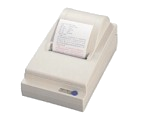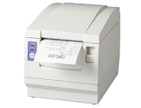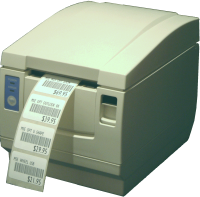 Impact Dot Matrix
Impact Dot MatrixFor many years, Impact Dot Matrix has been the workhorse of low cost printers. This printing method uses a ribbon which contains ink, and a print head with a series of "pins" which are fired onto the ribbon, pressing the ribbon against the paper. Where the ribbon contacts the paper, under pressure from these pins, an impression is made on the paper.
Dot matrix printers are required in cases where multiple layer pre-carbonised paper is used to produce a second copy of what is printed. Other printing technologies to not apply pressure to the paper which is needed to make the second copy readable.
Pre-carbonised paper is much more expensive than normal paper, was invented because very old dot matrix printers were too slow printing multiple copies. These days it is generally cheaper and better to print multiple copies on a thermal printer.
Dot Matrix printers are noisy, slow and produce poor quality printing with limited or no graphics capability. The color of the printouts comes from the ribbon color and usually single color, with some printers able to use a dual color ribbon.
They are relatively low in cost to operate, though ribbons need to be replaced at regular intervals.
Some models have relatively complex paper feed mechanisms which can make it difficult to load paper, and make the printer susceptible to paper jams.
 Direct Thermal
Direct ThermalDirect thermal printers have largely replaced dot matrix receipt printers at the point of sale.
They are relatively low cost, fast, quiet and usually have very easy paper load mechanisms where you insert the paper and close the printer.
These printers work using special thermal paper which changes color when heated. Thermal paper is slightly more expensive than ordinary paper, however no ribbon, ink or toner cartridge is required. This means that the cost is about the same as with dot matrix printers.
Direct Thermal printers are capable of quite good graphics for logos etc.
Dual color thermal printing is available on some models, however this requires special paper which is much more expensive, and rarely used. The color that appears on the paper depends on the temperature applied and the paper generally has a combination of Black/Red, Black/Green or Black/Blue. Most Star Micronics printers support dual color printing, and some Epson Models. The Epson models must have the paper type selected, or it will reduce the life of the thermal print head.
Direct thermal fades when exposed to ultraviolet light. This means printing which is exposed to direct sunlight will fade in a few months. In most cases this is acceptable, as indicated by the wide use of these printers particularly in convenience, grocery, fuel outlets and Bank ATM's.
 Thermal Transfer
Thermal TransferThermal transfer printers are similar to direct thermal printers, except that they do not use thermal paper, but do have a ribbon which is similar to the carbon ribbons used on old IBM golf ball typewriters, and the heating action on the print head bonds the color from the thermal ribbon to the paper.
Thermal Transfer printers are usually used for printing barcode labels and these printers produce very crisp lines and edges which are easy to read by barcode scanners.
Another important feature with thermal transfer printers is that the labels do not fade. Usually thermal transfer printers can also operate as direct thermal printers, with a configuration setting. Of course in that case the thermal ribbon would not be used, but thermal paper would be required.
The cost of consumables for thermal transfer printing is similar to direct thermal printing. You save money on the paper (thermal paper is more expensive), but you do have to buy ribbons, so the cost evens out. Thermal transfer printers, however do cost more.
Thermal transfer printers are normally used for label printing, and they produce a particularly crisp result which is ideal for printing barcodes.